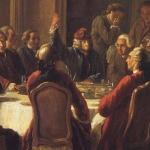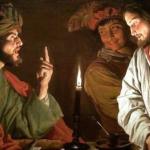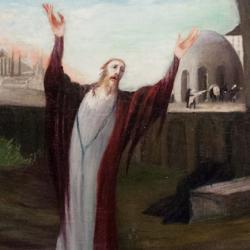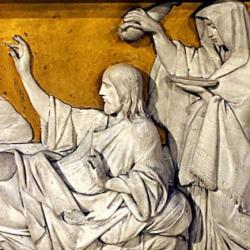Jesus starts His procession from the Mount of Olives, the mountain just east of Jerusalem across the Kidron Valley.
It’s the first time He has come to the Mount of Olives, but it takes on prominence in the last week of Jesus’ life. He begins His triumphal entry from the Mount of Olives. After He leaves the temple for the last time, He goes to the Mount of Olives to prophesy about Jerusalem’s doom (Matthew 24). After the Last Supper, He goes to the Mount of Olives with His disciples, and prays in the Garden of Gethsemane, the garden of the oil press (Matthew 26).
Why all this attention to the Mount of Olives? Why does Jesus camp out here during the last week of His life?
As James Jordan has noted, the olive tree is one of the plants created on Day 3 of the creation week. God makes trees with seed and grasses with seed; He makes, in short, fruit trees and grains. Before man is made from earth, vines, olives, and wheat spring from the earth. These three plants become emblematic plants, and their products – bread, wine, oil – take on a liturgical/sacramental role in Israel.
Bread is for priests, wine is for kings, oil for prophets. Oil represents the anointing of the Spirit, who turns human beings into light-bearers and warriors.
Everything in the temple was anointed with olive oil. The temple as a whole was a giant “light on a hill” designed to illumine the world around. The temple was an architectural type of the coming “Anointed One.” It was an olive grove.
More specifically, the Holy of Holies was an “anointed” space. The doors of Solomon’s temple were made of “oil wood,” and so were the guardian cherubim who flanked the ark of the covenant. Yahweh sat enthroned at the heart of an olive grove.
This last helps us see what’s happening in the final week of Jesus’ life. The mount of Olives becomes His base of operations. He sits (enthroned) to pronounce judgment against Jerusalem (24:3), and He enters the olive grove to plead with His Father in the garden. It’s Jesus’ Most Holy Place.
If the Mount of Olives becomes the Most Holy Place, then the temple has become something else. It has become the outer court, and will eventually be expelled entirely, as an unclean thing.
This last helps us see what’s happening in the final week of Jesus’ life. The mount of Olives becomes His base of operations. He sits (enthroned) to pronounce judgment against Jerusalem (24:3), and He enters the olive grove to plead with His Father in the garden. It’s Jesus’ Most Holy Place. It’s the debir, the place of the word; it’s the throne room of Jesus, who is the glory of God.
Jesus’ triumphal entry begins from this new “inner sanctuary” – the inner sanctuary which is now outside the gates. The “nave” of the temple (the Holy Place) was carved with palm trees, and so Jesus moves from the olive mountain over palm branches toward the “outer court” that is the temple. Jesus is the king coming into His capital city; He is also the king, descending from His throne, to visit His city and conduct a review.
Yahweh has done this before. He has moved from the inner sanctuary out among the people. When the tabernacle was finished, Nadab and Abihu offered strange fire before Yahweh, and He burst out with fire of His own. When Korah rebelled against Moses, a fiery pestilence burst out from the sanctuary to destroy the people. Yahweh sends out prophets who wrangle with unfaithful priests in the temple courts (cf. Jeremiah). Jesus is the incarnate fire of God who comes from the inner sanctuary of Olives to wrangle with scribes, Pharisees, Sadducees and Herodians.
An observer on Palm Sunday would have seen the opposite. It looks as if Jesus is moving from outside in, from outside Jerusalem toward the city and temple. But Jesus has begun to scramble the map. What looks like a movement from outside in is in fact a movement from inside out. Jesus is beginning to turn the world inside out.
Inside becomes outside; the most holy place moves outside the gate; where there was once an ark-throne of gold, there is now a cross and an empty tomb.












